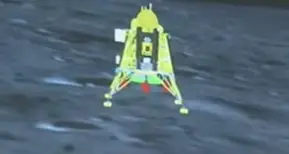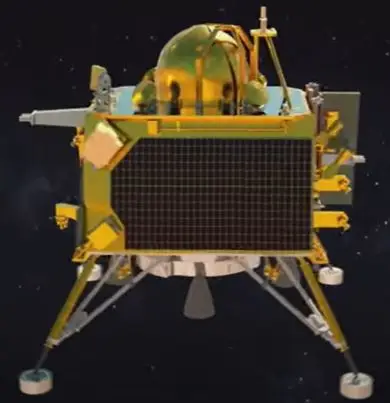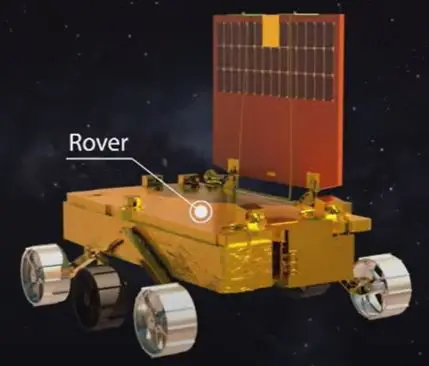India’s Chandrayaan 3 mission made history on Wednesday, August 23, 2023, when it soft-landed on the moon’s south pole. The mission is the first of its kind in the world, and it is a major milestone for India’s space program.

Table of Contents
The Chandrayaan 3 mission consists of three spacecraft: an orbiter, a lander, and a rover. The orbiter will study the moon’s surface and atmosphere, while the lander will deploy the rover to explore the lunar surface. The rover is equipped with various scientific instruments, including a camera, a spectrometer, and a magnetometer.
The soft landing on the moon was challenging, but the Chandrayaan 3 mission team successfully achieved it. The lander touched down at 6:04 p.m. IST on the moon’s south pole. The landing site is located in a region rich in water ice, a valuable resource for future space exploration.
The successful landing of Chandrayaan 3 is a major achievement for India’s space program. It is a testament to the hard work and dedication of the Indian scientists and engineers who worked on the mission. The mission marks a significant step in India’s journey to become a leading spacefaring nation.
The success of Chandrayaan 3 is a source of pride for all Indians. It is a reminder that India can achieve great things and inspires us to dream big about the future.
In the coming days and weeks, the Chandrayaan 3 mission team will be busy commissioning the spacecraft and preparing for the rover’s deployment. We can look forward to exciting discoveries from the Chandrayaan 3 mission, and we are proud to be a part of this historic moment.
Introduction
(adsbygoogle = window.adsbygoogle || []).push({});India’s Chandrayaan 3 mission is a robotic spacecraft launched on July 14, 2023, from the Satish Dhawan Space Centre in Sriharikota, Andhra Pradesh. The mission aims to soft-land a rover on the moon’s south pole.
The Chandrayaan 3 mission consists of three spacecraft:
Orbiter: The Chandrayaan 3 orbiter will remain in orbit around the moon. It will provide communication and navigation support for the lander and rover. The orbiter will also conduct its scientific experiments to study the moon’s atmosphere and gravity field.
The orbiter is about 2.5 meters tall and 4 meters wide. It has a solar panel that provides it with power. The orbiter will operate for about one year.
The orbiter is equipped with a variety of scientific instruments, including:
- A camera to take images of the moon’s surface
- A spectrometer to analyze the composition of the moon’s atmosphere
- A gravity field sensor to measure the moon’s gravity field
Lander: The Chandrayaan 3 lander is the heart of the mission. It is responsible for soft-landing the rover on the moon’s surface and providing it with power and communications. The lander is also equipped with scientific instruments to conduct experiments to study the moon’s surface and atmosphere.
The lander is about 6 meters tall and 2 meters wide. It has four legs that will help it to absorb the shock of landing. The lander also has a series of engines and thrusters to help it maneuver on the moon’s surface.
The lander is powered by a battery that will give it power for about 100 days. The lander also has solar panels that will help to recharge the battery.
The lander is equipped with a variety of scientific instruments, including:
- A camera to take images of the moon’s surface
- A spectrometer to analyze the composition of the moon’s soil
- A magnetometer to measure the moon’s magnetic field

Rover: The Chandrayaan 3 rover is a small, six-wheeled vehicle that the lander will deploy. The rover is about 1 meter tall and 2 meters long. It has a variety of scientific instruments, including:
- A camera to take images of the moon’s surface
- A spectrometer to analyze the composition of the moon’s soil
- A magnetometer to measure the moon’s magnetic field
- A drill to collect samples of the moon’s soil
The rover can travel about 500 meters on the moon’s surface. It will operate for about 100 days.

The Soft Landing
The soft landing on the moon was challenging, but the Chandrayaan 3 mission team successfully achieved it. The lander touched down at 6:04 pm IST on the moon’s south pole. The landing site is located in a region rich in water ice, a valuable resource for future space exploration.
The soft landing involved several complex maneuvers. The lander first entered a lunar orbit. It then fired its engines to reduce speed and descend to the surface. The lander used a variety of sensors to ensure that it landed safely.
The successful landing of Chandrayaan 3 is a major achievement for India’s space program. It is a testament to the hard work and dedication of the Indian scientists and engineers who worked on the mission. The mission marks a significant step in India’s journey to become a leading spacefaring nation.
Scientific Objectives
(adsbygoogle = window.adsbygoogle || []).push({});The Chandrayaan 3 mission has several scientific objectives. These include:
- Studying the moon’s surface and atmosphere
- Searching for water ice and other resources on the moon
- Understanding the moon’s formation and evolution
- Exploring the potential of the moon for future human exploration
The scientific instruments on the Chandrayaan 3 spacecraft will collect data to help achieve these objectives. Scientists around the world will analyze the data.
The Future of Chandrayaan 3
The Chandrayaan 3 mission is just the beginning of India’s moon exploration. The Indian Space Research Organisation (ISRO) is planning several follow-on missions. These missions will build on the Chandrayaan 3 mission and further our understanding of the moon.
The ISRO is also planning to send humans to the moon. The Chandrayaan 3 mission is an important step towards this goal.
Conclusion
The successful landing of Chandrayaan 3 is a major achievement for India and the world. It is a reminder that India is a leading spacefaring nation, and it inspires us to dream big about the future of space exploration.
(adsbygoogle = window.adsbygoogle || []).push({});